Maternity Nurse Role, Baby Care, and Safeguarding Practices
VerifiedAdded on 2023/06/10
|9
|4932
|167
Homework Assignment
AI Summary
This assignment explores the multifaceted role of a maternity nurse. Section 1 focuses on the nurse's responsibilities, including explaining the role, outlining key strengths, and addressing safeguarding concerns related to child abuse and confidentiality. It emphasizes the importance of maintaining confidentiality, outlines steps for reporting suspected abuse, and provides strategies for building effective partnerships with parents. Section 2 delves into practical aspects of newborn care, such as washing techniques, common skin features, and addressing concerns about weight loss. The assignment offers guidance on bathing a baby, recognizing normal skin characteristics, and addressing parental concerns about infant sleep and comfort, providing a comprehensive overview of the maternity nurse's responsibilities and practical skills.
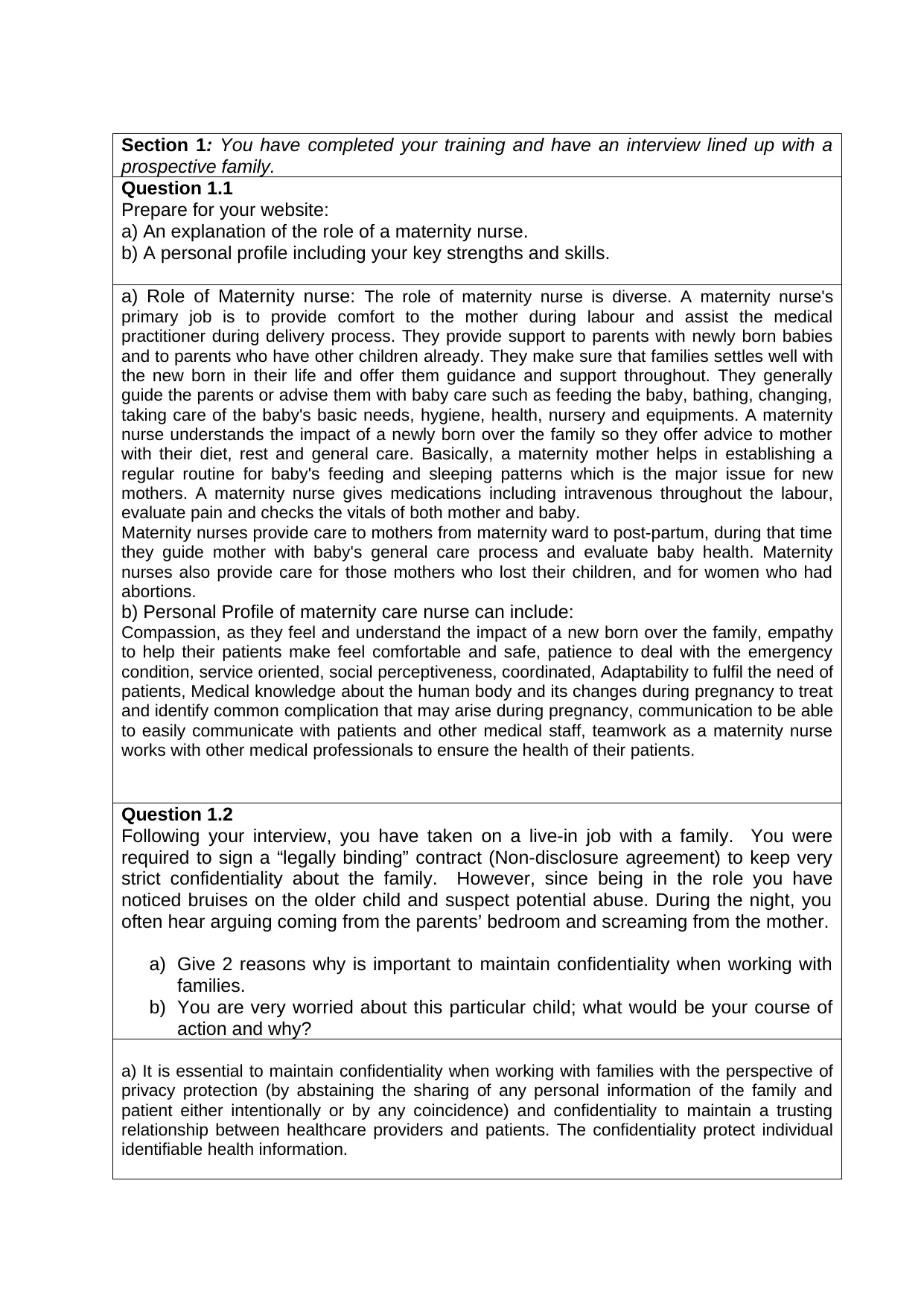
Section 1: You have completed your training and have an interview lined up with a
prospective family.
Question 1.1
Prepare for your website:
a) An explanation of the role of a maternity nurse.
b) A personal profile including your key strengths and skills.
a) Role of Maternity nurse: The role of maternity nurse is diverse. A maternity nurse's
primary job is to provide comfort to the mother during labour and assist the medical
practitioner during delivery process. They provide support to parents with newly born babies
and to parents who have other children already. They make sure that families settles well with
the new born in their life and offer them guidance and support throughout. They generally
guide the parents or advise them with baby care such as feeding the baby, bathing, changing,
taking care of the baby's basic needs, hygiene, health, nursery and equipments. A maternity
nurse understands the impact of a newly born over the family so they offer advice to mother
with their diet, rest and general care. Basically, a maternity mother helps in establishing a
regular routine for baby's feeding and sleeping patterns which is the major issue for new
mothers. A maternity nurse gives medications including intravenous throughout the labour,
evaluate pain and checks the vitals of both mother and baby.
Maternity nurses provide care to mothers from maternity ward to post-partum, during that time
they guide mother with baby's general care process and evaluate baby health. Maternity
nurses also provide care for those mothers who lost their children, and for women who had
abortions.
b) Personal Profile of maternity care nurse can include:
Compassion, as they feel and understand the impact of a new born over the family, empathy
to help their patients make feel comfortable and safe, patience to deal with the emergency
condition, service oriented, social perceptiveness, coordinated, Adaptability to fulfil the need of
patients, Medical knowledge about the human body and its changes during pregnancy to treat
and identify common complication that may arise during pregnancy, communication to be able
to easily communicate with patients and other medical staff, teamwork as a maternity nurse
works with other medical professionals to ensure the health of their patients.
Question 1.2
Following your interview, you have taken on a live-in job with a family. You were
required to sign a “legally binding” contract (Non-disclosure agreement) to keep very
strict confidentiality about the family. However, since being in the role you have
noticed bruises on the older child and suspect potential abuse. During the night, you
often hear arguing coming from the parents’ bedroom and screaming from the mother.
a) Give 2 reasons why is important to maintain confidentiality when working with
families.
b) You are very worried about this particular child; what would be your course of
action and why?
a) It is essential to maintain confidentiality when working with families with the perspective of
privacy protection (by abstaining the sharing of any personal information of the family and
patient either intentionally or by any coincidence) and confidentiality to maintain a trusting
relationship between healthcare providers and patients. The confidentiality protect individual
identifiable health information.
prospective family.
Question 1.1
Prepare for your website:
a) An explanation of the role of a maternity nurse.
b) A personal profile including your key strengths and skills.
a) Role of Maternity nurse: The role of maternity nurse is diverse. A maternity nurse's
primary job is to provide comfort to the mother during labour and assist the medical
practitioner during delivery process. They provide support to parents with newly born babies
and to parents who have other children already. They make sure that families settles well with
the new born in their life and offer them guidance and support throughout. They generally
guide the parents or advise them with baby care such as feeding the baby, bathing, changing,
taking care of the baby's basic needs, hygiene, health, nursery and equipments. A maternity
nurse understands the impact of a newly born over the family so they offer advice to mother
with their diet, rest and general care. Basically, a maternity mother helps in establishing a
regular routine for baby's feeding and sleeping patterns which is the major issue for new
mothers. A maternity nurse gives medications including intravenous throughout the labour,
evaluate pain and checks the vitals of both mother and baby.
Maternity nurses provide care to mothers from maternity ward to post-partum, during that time
they guide mother with baby's general care process and evaluate baby health. Maternity
nurses also provide care for those mothers who lost their children, and for women who had
abortions.
b) Personal Profile of maternity care nurse can include:
Compassion, as they feel and understand the impact of a new born over the family, empathy
to help their patients make feel comfortable and safe, patience to deal with the emergency
condition, service oriented, social perceptiveness, coordinated, Adaptability to fulfil the need of
patients, Medical knowledge about the human body and its changes during pregnancy to treat
and identify common complication that may arise during pregnancy, communication to be able
to easily communicate with patients and other medical staff, teamwork as a maternity nurse
works with other medical professionals to ensure the health of their patients.
Question 1.2
Following your interview, you have taken on a live-in job with a family. You were
required to sign a “legally binding” contract (Non-disclosure agreement) to keep very
strict confidentiality about the family. However, since being in the role you have
noticed bruises on the older child and suspect potential abuse. During the night, you
often hear arguing coming from the parents’ bedroom and screaming from the mother.
a) Give 2 reasons why is important to maintain confidentiality when working with
families.
b) You are very worried about this particular child; what would be your course of
action and why?
a) It is essential to maintain confidentiality when working with families with the perspective of
privacy protection (by abstaining the sharing of any personal information of the family and
patient either intentionally or by any coincidence) and confidentiality to maintain a trusting
relationship between healthcare providers and patients. The confidentiality protect individual
identifiable health information.
Paraphrase This Document
Need a fresh take? Get an instant paraphrase of this document with our AI Paraphraser
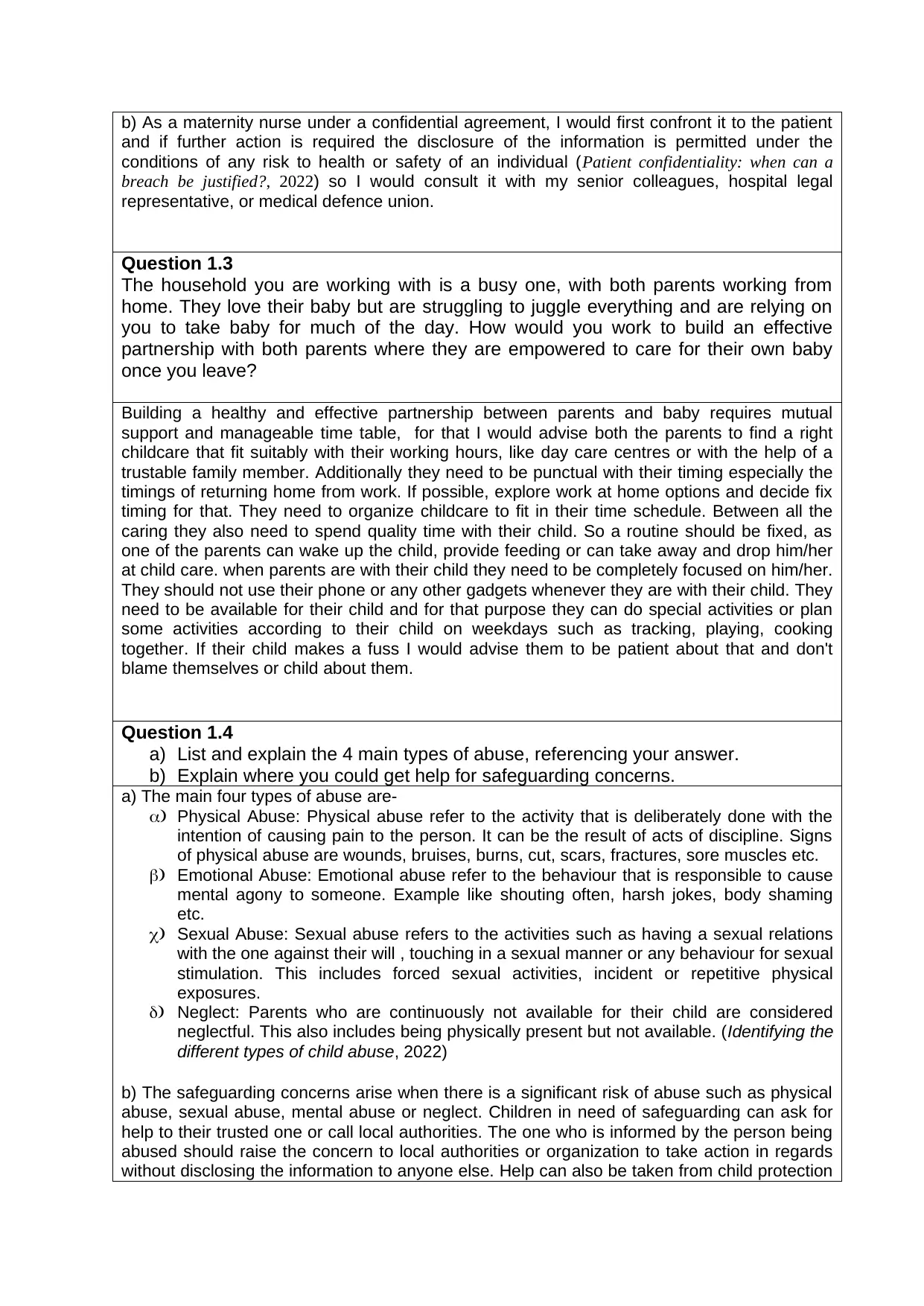
b) As a maternity nurse under a confidential agreement, I would first confront it to the patient
and if further action is required the disclosure of the information is permitted under the
conditions of any risk to health or safety of an individual (Patient confidentiality: when can a
breach be justified?, 2022) so I would consult it with my senior colleagues, hospital legal
representative, or medical defence union.
Question 1.3
The household you are working with is a busy one, with both parents working from
home. They love their baby but are struggling to juggle everything and are relying on
you to take baby for much of the day. How would you work to build an effective
partnership with both parents where they are empowered to care for their own baby
once you leave?
Building a healthy and effective partnership between parents and baby requires mutual
support and manageable time table, for that I would advise both the parents to find a right
childcare that fit suitably with their working hours, like day care centres or with the help of a
trustable family member. Additionally they need to be punctual with their timing especially the
timings of returning home from work. If possible, explore work at home options and decide fix
timing for that. They need to organize childcare to fit in their time schedule. Between all the
caring they also need to spend quality time with their child. So a routine should be fixed, as
one of the parents can wake up the child, provide feeding or can take away and drop him/her
at child care. when parents are with their child they need to be completely focused on him/her.
They should not use their phone or any other gadgets whenever they are with their child. They
need to be available for their child and for that purpose they can do special activities or plan
some activities according to their child on weekdays such as tracking, playing, cooking
together. If their child makes a fuss I would advise them to be patient about that and don't
blame themselves or child about them.
Question 1.4
a) List and explain the 4 main types of abuse, referencing your answer.
b) Explain where you could get help for safeguarding concerns.
a) The main four types of abuse are-
a) Physical Abuse: Physical abuse refer to the activity that is deliberately done with the
intention of causing pain to the person. It can be the result of acts of discipline. Signs
of physical abuse are wounds, bruises, burns, cut, scars, fractures, sore muscles etc.
b) Emotional Abuse: Emotional abuse refer to the behaviour that is responsible to cause
mental agony to someone. Example like shouting often, harsh jokes, body shaming
etc.
c) Sexual Abuse: Sexual abuse refers to the activities such as having a sexual relations
with the one against their will , touching in a sexual manner or any behaviour for sexual
stimulation. This includes forced sexual activities, incident or repetitive physical
exposures.
d) Neglect: Parents who are continuously not available for their child are considered
neglectful. This also includes being physically present but not available. (Identifying the
different types of child abuse, 2022)
b) The safeguarding concerns arise when there is a significant risk of abuse such as physical
abuse, sexual abuse, mental abuse or neglect. Children in need of safeguarding can ask for
help to their trusted one or call local authorities. The one who is informed by the person being
abused should raise the concern to local authorities or organization to take action in regards
without disclosing the information to anyone else. Help can also be taken from child protection
and if further action is required the disclosure of the information is permitted under the
conditions of any risk to health or safety of an individual (Patient confidentiality: when can a
breach be justified?, 2022) so I would consult it with my senior colleagues, hospital legal
representative, or medical defence union.
Question 1.3
The household you are working with is a busy one, with both parents working from
home. They love their baby but are struggling to juggle everything and are relying on
you to take baby for much of the day. How would you work to build an effective
partnership with both parents where they are empowered to care for their own baby
once you leave?
Building a healthy and effective partnership between parents and baby requires mutual
support and manageable time table, for that I would advise both the parents to find a right
childcare that fit suitably with their working hours, like day care centres or with the help of a
trustable family member. Additionally they need to be punctual with their timing especially the
timings of returning home from work. If possible, explore work at home options and decide fix
timing for that. They need to organize childcare to fit in their time schedule. Between all the
caring they also need to spend quality time with their child. So a routine should be fixed, as
one of the parents can wake up the child, provide feeding or can take away and drop him/her
at child care. when parents are with their child they need to be completely focused on him/her.
They should not use their phone or any other gadgets whenever they are with their child. They
need to be available for their child and for that purpose they can do special activities or plan
some activities according to their child on weekdays such as tracking, playing, cooking
together. If their child makes a fuss I would advise them to be patient about that and don't
blame themselves or child about them.
Question 1.4
a) List and explain the 4 main types of abuse, referencing your answer.
b) Explain where you could get help for safeguarding concerns.
a) The main four types of abuse are-
a) Physical Abuse: Physical abuse refer to the activity that is deliberately done with the
intention of causing pain to the person. It can be the result of acts of discipline. Signs
of physical abuse are wounds, bruises, burns, cut, scars, fractures, sore muscles etc.
b) Emotional Abuse: Emotional abuse refer to the behaviour that is responsible to cause
mental agony to someone. Example like shouting often, harsh jokes, body shaming
etc.
c) Sexual Abuse: Sexual abuse refers to the activities such as having a sexual relations
with the one against their will , touching in a sexual manner or any behaviour for sexual
stimulation. This includes forced sexual activities, incident or repetitive physical
exposures.
d) Neglect: Parents who are continuously not available for their child are considered
neglectful. This also includes being physically present but not available. (Identifying the
different types of child abuse, 2022)
b) The safeguarding concerns arise when there is a significant risk of abuse such as physical
abuse, sexual abuse, mental abuse or neglect. Children in need of safeguarding can ask for
help to their trusted one or call local authorities. The one who is informed by the person being
abused should raise the concern to local authorities or organization to take action in regards
without disclosing the information to anyone else. Help can also be taken from child protection
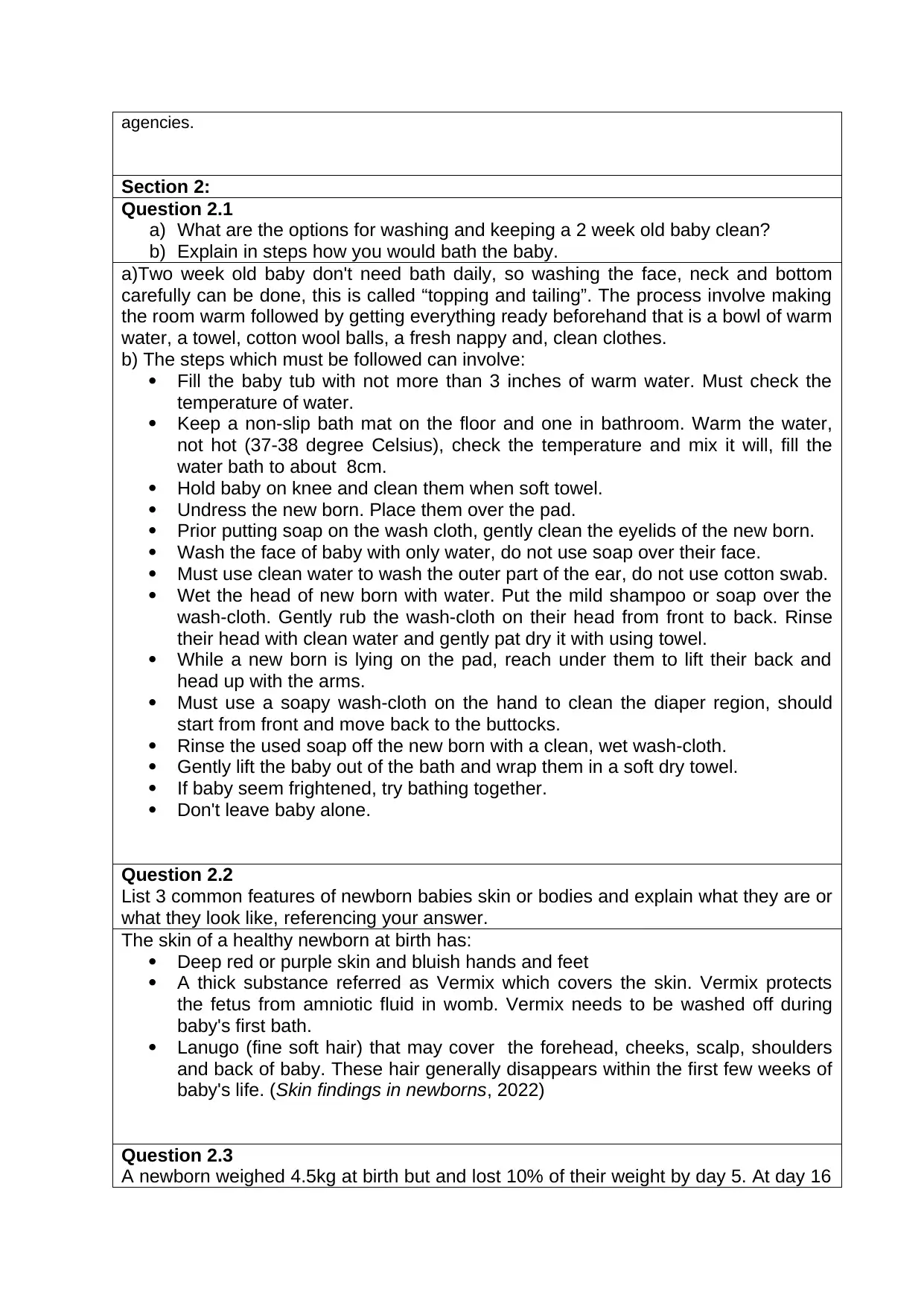
agencies.
Section 2:
Question 2.1
a) What are the options for washing and keeping a 2 week old baby clean?
b) Explain in steps how you would bath the baby.
a)Two week old baby don't need bath daily, so washing the face, neck and bottom
carefully can be done, this is called “topping and tailing”. The process involve making
the room warm followed by getting everything ready beforehand that is a bowl of warm
water, a towel, cotton wool balls, a fresh nappy and, clean clothes.
b) The steps which must be followed can involve:
Fill the baby tub with not more than 3 inches of warm water. Must check the
temperature of water.
Keep a non-slip bath mat on the floor and one in bathroom. Warm the water,
not hot (37-38 degree Celsius), check the temperature and mix it will, fill the
water bath to about 8cm.
Hold baby on knee and clean them when soft towel.
Undress the new born. Place them over the pad.
Prior putting soap on the wash cloth, gently clean the eyelids of the new born.
Wash the face of baby with only water, do not use soap over their face.
Must use clean water to wash the outer part of the ear, do not use cotton swab.
Wet the head of new born with water. Put the mild shampoo or soap over the
wash-cloth. Gently rub the wash-cloth on their head from front to back. Rinse
their head with clean water and gently pat dry it with using towel.
While a new born is lying on the pad, reach under them to lift their back and
head up with the arms.
Must use a soapy wash-cloth on the hand to clean the diaper region, should
start from front and move back to the buttocks.
Rinse the used soap off the new born with a clean, wet wash-cloth.
Gently lift the baby out of the bath and wrap them in a soft dry towel.
If baby seem frightened, try bathing together.
Don't leave baby alone.
Question 2.2
List 3 common features of newborn babies skin or bodies and explain what they are or
what they look like, referencing your answer.
The skin of a healthy newborn at birth has:
Deep red or purple skin and bluish hands and feet
A thick substance referred as Vermix which covers the skin. Vermix protects
the fetus from amniotic fluid in womb. Vermix needs to be washed off during
baby's first bath.
Lanugo (fine soft hair) that may cover the forehead, cheeks, scalp, shoulders
and back of baby. These hair generally disappears within the first few weeks of
baby's life. (Skin findings in newborns, 2022)
Question 2.3
A newborn weighed 4.5kg at birth but and lost 10% of their weight by day 5. At day 16
Section 2:
Question 2.1
a) What are the options for washing and keeping a 2 week old baby clean?
b) Explain in steps how you would bath the baby.
a)Two week old baby don't need bath daily, so washing the face, neck and bottom
carefully can be done, this is called “topping and tailing”. The process involve making
the room warm followed by getting everything ready beforehand that is a bowl of warm
water, a towel, cotton wool balls, a fresh nappy and, clean clothes.
b) The steps which must be followed can involve:
Fill the baby tub with not more than 3 inches of warm water. Must check the
temperature of water.
Keep a non-slip bath mat on the floor and one in bathroom. Warm the water,
not hot (37-38 degree Celsius), check the temperature and mix it will, fill the
water bath to about 8cm.
Hold baby on knee and clean them when soft towel.
Undress the new born. Place them over the pad.
Prior putting soap on the wash cloth, gently clean the eyelids of the new born.
Wash the face of baby with only water, do not use soap over their face.
Must use clean water to wash the outer part of the ear, do not use cotton swab.
Wet the head of new born with water. Put the mild shampoo or soap over the
wash-cloth. Gently rub the wash-cloth on their head from front to back. Rinse
their head with clean water and gently pat dry it with using towel.
While a new born is lying on the pad, reach under them to lift their back and
head up with the arms.
Must use a soapy wash-cloth on the hand to clean the diaper region, should
start from front and move back to the buttocks.
Rinse the used soap off the new born with a clean, wet wash-cloth.
Gently lift the baby out of the bath and wrap them in a soft dry towel.
If baby seem frightened, try bathing together.
Don't leave baby alone.
Question 2.2
List 3 common features of newborn babies skin or bodies and explain what they are or
what they look like, referencing your answer.
The skin of a healthy newborn at birth has:
Deep red or purple skin and bluish hands and feet
A thick substance referred as Vermix which covers the skin. Vermix protects
the fetus from amniotic fluid in womb. Vermix needs to be washed off during
baby's first bath.
Lanugo (fine soft hair) that may cover the forehead, cheeks, scalp, shoulders
and back of baby. These hair generally disappears within the first few weeks of
baby's life. (Skin findings in newborns, 2022)
Question 2.3
A newborn weighed 4.5kg at birth but and lost 10% of their weight by day 5. At day 16
⊘ This is a preview!⊘
Do you want full access?
Subscribe today to unlock all pages.

Trusted by 1+ million students worldwide
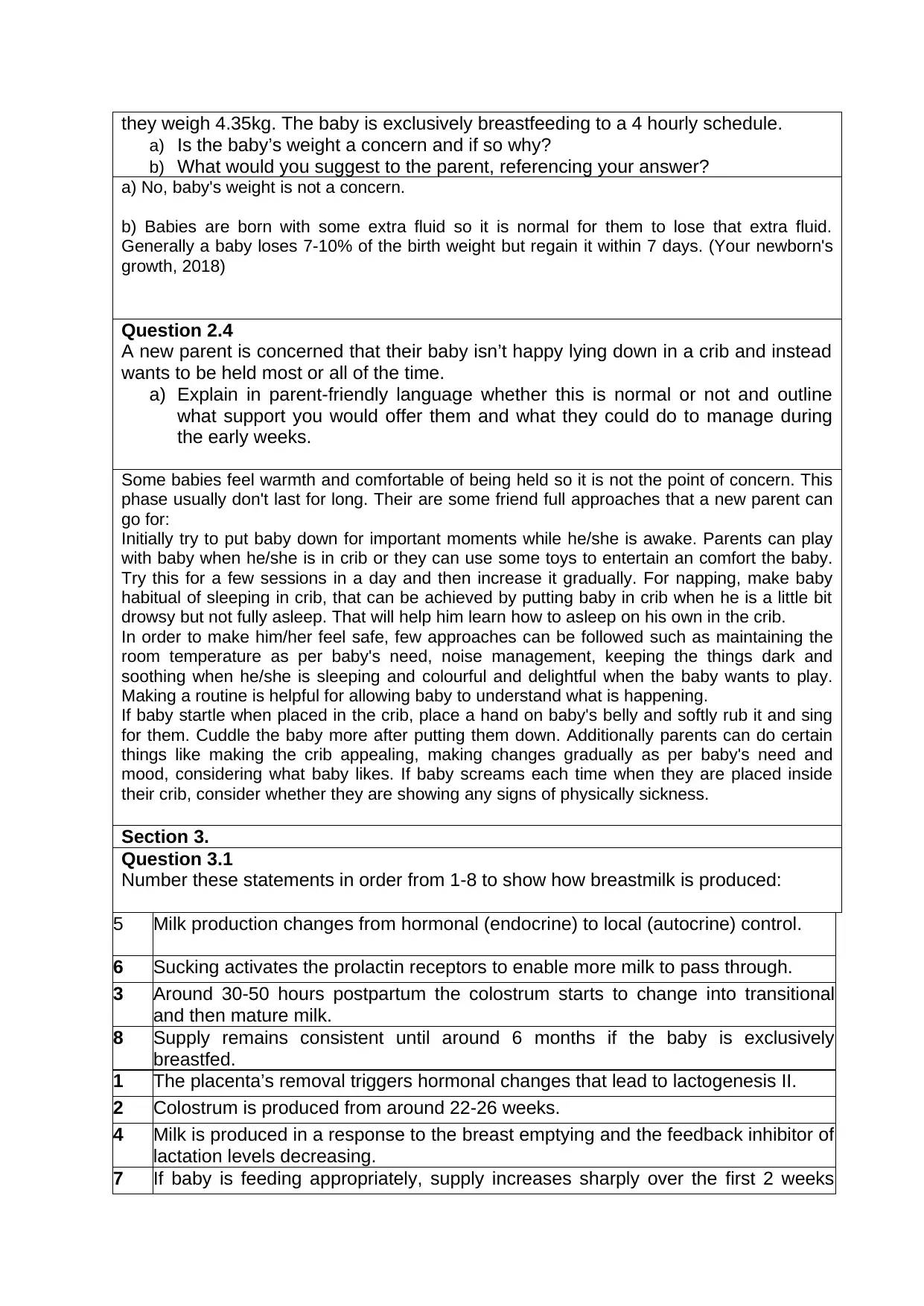
they weigh 4.35kg. The baby is exclusively breastfeeding to a 4 hourly schedule.
a) Is the baby’s weight a concern and if so why?
b) What would you suggest to the parent, referencing your answer?
a) No, baby's weight is not a concern.
b) Babies are born with some extra fluid so it is normal for them to lose that extra fluid.
Generally a baby loses 7-10% of the birth weight but regain it within 7 days. (Your newborn's
growth, 2018)
Question 2.4
A new parent is concerned that their baby isn’t happy lying down in a crib and instead
wants to be held most or all of the time.
a) Explain in parent-friendly language whether this is normal or not and outline
what support you would offer them and what they could do to manage during
the early weeks.
Some babies feel warmth and comfortable of being held so it is not the point of concern. This
phase usually don't last for long. Their are some friend full approaches that a new parent can
go for:
Initially try to put baby down for important moments while he/she is awake. Parents can play
with baby when he/she is in crib or they can use some toys to entertain an comfort the baby.
Try this for a few sessions in a day and then increase it gradually. For napping, make baby
habitual of sleeping in crib, that can be achieved by putting baby in crib when he is a little bit
drowsy but not fully asleep. That will help him learn how to asleep on his own in the crib.
In order to make him/her feel safe, few approaches can be followed such as maintaining the
room temperature as per baby's need, noise management, keeping the things dark and
soothing when he/she is sleeping and colourful and delightful when the baby wants to play.
Making a routine is helpful for allowing baby to understand what is happening.
If baby startle when placed in the crib, place a hand on baby's belly and softly rub it and sing
for them. Cuddle the baby more after putting them down. Additionally parents can do certain
things like making the crib appealing, making changes gradually as per baby's need and
mood, considering what baby likes. If baby screams each time when they are placed inside
their crib, consider whether they are showing any signs of physically sickness.
Section 3.
Question 3.1
Number these statements in order from 1-8 to show how breastmilk is produced:
5 Milk production changes from hormonal (endocrine) to local (autocrine) control.
6 Sucking activates the prolactin receptors to enable more milk to pass through.
3 Around 30-50 hours postpartum the colostrum starts to change into transitional
and then mature milk.
8 Supply remains consistent until around 6 months if the baby is exclusively
breastfed.
1 The placenta’s removal triggers hormonal changes that lead to lactogenesis II.
2 Colostrum is produced from around 22-26 weeks.
4 Milk is produced in a response to the breast emptying and the feedback inhibitor of
lactation levels decreasing.
7 If baby is feeding appropriately, supply increases sharply over the first 2 weeks
a) Is the baby’s weight a concern and if so why?
b) What would you suggest to the parent, referencing your answer?
a) No, baby's weight is not a concern.
b) Babies are born with some extra fluid so it is normal for them to lose that extra fluid.
Generally a baby loses 7-10% of the birth weight but regain it within 7 days. (Your newborn's
growth, 2018)
Question 2.4
A new parent is concerned that their baby isn’t happy lying down in a crib and instead
wants to be held most or all of the time.
a) Explain in parent-friendly language whether this is normal or not and outline
what support you would offer them and what they could do to manage during
the early weeks.
Some babies feel warmth and comfortable of being held so it is not the point of concern. This
phase usually don't last for long. Their are some friend full approaches that a new parent can
go for:
Initially try to put baby down for important moments while he/she is awake. Parents can play
with baby when he/she is in crib or they can use some toys to entertain an comfort the baby.
Try this for a few sessions in a day and then increase it gradually. For napping, make baby
habitual of sleeping in crib, that can be achieved by putting baby in crib when he is a little bit
drowsy but not fully asleep. That will help him learn how to asleep on his own in the crib.
In order to make him/her feel safe, few approaches can be followed such as maintaining the
room temperature as per baby's need, noise management, keeping the things dark and
soothing when he/she is sleeping and colourful and delightful when the baby wants to play.
Making a routine is helpful for allowing baby to understand what is happening.
If baby startle when placed in the crib, place a hand on baby's belly and softly rub it and sing
for them. Cuddle the baby more after putting them down. Additionally parents can do certain
things like making the crib appealing, making changes gradually as per baby's need and
mood, considering what baby likes. If baby screams each time when they are placed inside
their crib, consider whether they are showing any signs of physically sickness.
Section 3.
Question 3.1
Number these statements in order from 1-8 to show how breastmilk is produced:
5 Milk production changes from hormonal (endocrine) to local (autocrine) control.
6 Sucking activates the prolactin receptors to enable more milk to pass through.
3 Around 30-50 hours postpartum the colostrum starts to change into transitional
and then mature milk.
8 Supply remains consistent until around 6 months if the baby is exclusively
breastfed.
1 The placenta’s removal triggers hormonal changes that lead to lactogenesis II.
2 Colostrum is produced from around 22-26 weeks.
4 Milk is produced in a response to the breast emptying and the feedback inhibitor of
lactation levels decreasing.
7 If baby is feeding appropriately, supply increases sharply over the first 2 weeks
Paraphrase This Document
Need a fresh take? Get an instant paraphrase of this document with our AI Paraphraser
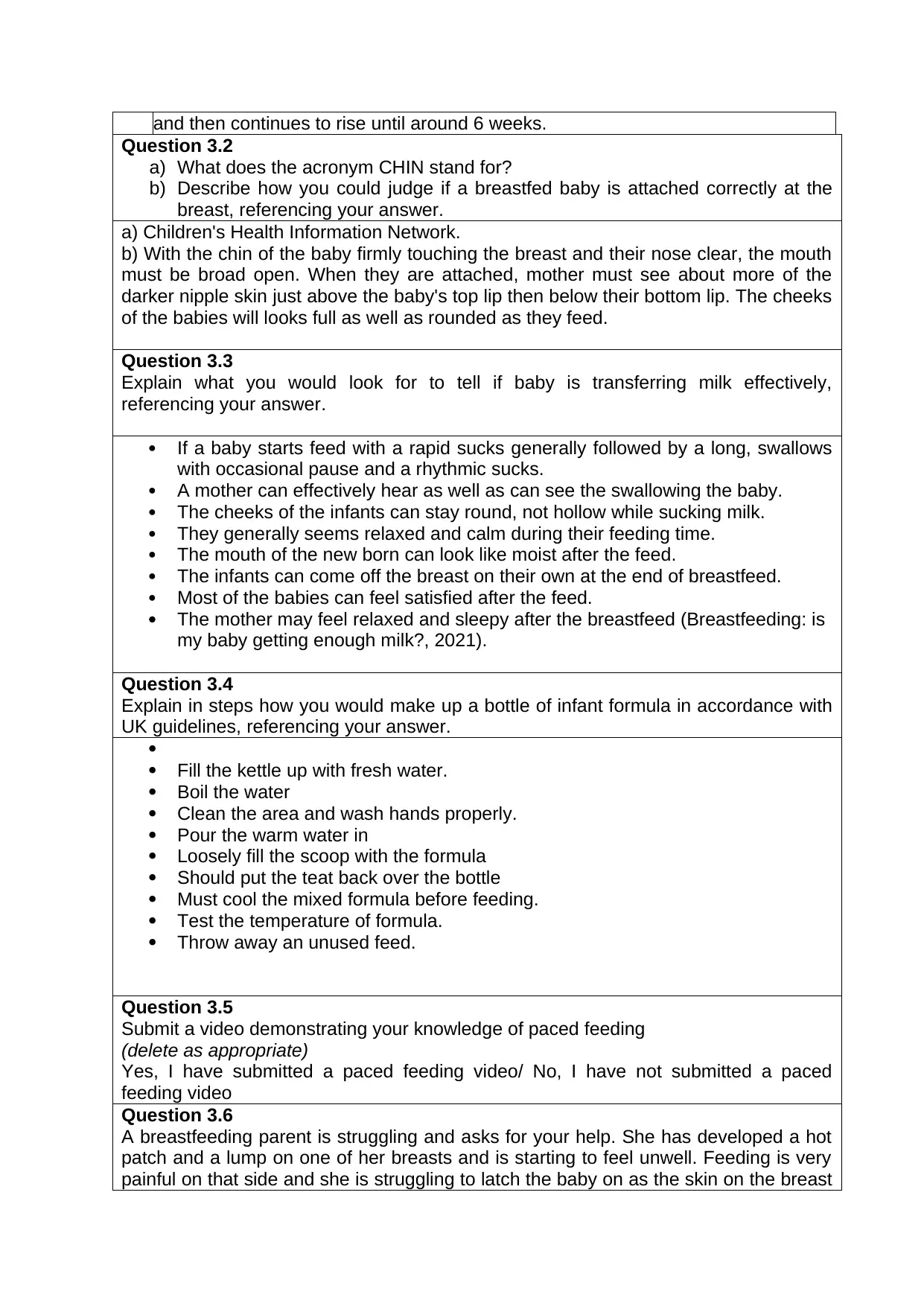
and then continues to rise until around 6 weeks.
Question 3.2
a) What does the acronym CHIN stand for?
b) Describe how you could judge if a breastfed baby is attached correctly at the
breast, referencing your answer.
a) Children's Health Information Network.
b) With the chin of the baby firmly touching the breast and their nose clear, the mouth
must be broad open. When they are attached, mother must see about more of the
darker nipple skin just above the baby's top lip then below their bottom lip. The cheeks
of the babies will looks full as well as rounded as they feed.
Question 3.3
Explain what you would look for to tell if baby is transferring milk effectively,
referencing your answer.
If a baby starts feed with a rapid sucks generally followed by a long, swallows
with occasional pause and a rhythmic sucks.
A mother can effectively hear as well as can see the swallowing the baby.
The cheeks of the infants can stay round, not hollow while sucking milk.
They generally seems relaxed and calm during their feeding time.
The mouth of the new born can look like moist after the feed.
The infants can come off the breast on their own at the end of breastfeed.
Most of the babies can feel satisfied after the feed.
The mother may feel relaxed and sleepy after the breastfeed (Breastfeeding: is
my baby getting enough milk?, 2021).
Question 3.4
Explain in steps how you would make up a bottle of infant formula in accordance with
UK guidelines, referencing your answer.
Fill the kettle up with fresh water.
Boil the water
Clean the area and wash hands properly.
Pour the warm water in
Loosely fill the scoop with the formula
Should put the teat back over the bottle
Must cool the mixed formula before feeding.
Test the temperature of formula.
Throw away an unused feed.
Question 3.5
Submit a video demonstrating your knowledge of paced feeding
(delete as appropriate)
Yes, I have submitted a paced feeding video/ No, I have not submitted a paced
feeding video
Question 3.6
A breastfeeding parent is struggling and asks for your help. She has developed a hot
patch and a lump on one of her breasts and is starting to feel unwell. Feeding is very
painful on that side and she is struggling to latch the baby on as the skin on the breast
Question 3.2
a) What does the acronym CHIN stand for?
b) Describe how you could judge if a breastfed baby is attached correctly at the
breast, referencing your answer.
a) Children's Health Information Network.
b) With the chin of the baby firmly touching the breast and their nose clear, the mouth
must be broad open. When they are attached, mother must see about more of the
darker nipple skin just above the baby's top lip then below their bottom lip. The cheeks
of the babies will looks full as well as rounded as they feed.
Question 3.3
Explain what you would look for to tell if baby is transferring milk effectively,
referencing your answer.
If a baby starts feed with a rapid sucks generally followed by a long, swallows
with occasional pause and a rhythmic sucks.
A mother can effectively hear as well as can see the swallowing the baby.
The cheeks of the infants can stay round, not hollow while sucking milk.
They generally seems relaxed and calm during their feeding time.
The mouth of the new born can look like moist after the feed.
The infants can come off the breast on their own at the end of breastfeed.
Most of the babies can feel satisfied after the feed.
The mother may feel relaxed and sleepy after the breastfeed (Breastfeeding: is
my baby getting enough milk?, 2021).
Question 3.4
Explain in steps how you would make up a bottle of infant formula in accordance with
UK guidelines, referencing your answer.
Fill the kettle up with fresh water.
Boil the water
Clean the area and wash hands properly.
Pour the warm water in
Loosely fill the scoop with the formula
Should put the teat back over the bottle
Must cool the mixed formula before feeding.
Test the temperature of formula.
Throw away an unused feed.
Question 3.5
Submit a video demonstrating your knowledge of paced feeding
(delete as appropriate)
Yes, I have submitted a paced feeding video/ No, I have not submitted a paced
feeding video
Question 3.6
A breastfeeding parent is struggling and asks for your help. She has developed a hot
patch and a lump on one of her breasts and is starting to feel unwell. Feeding is very
painful on that side and she is struggling to latch the baby on as the skin on the breast
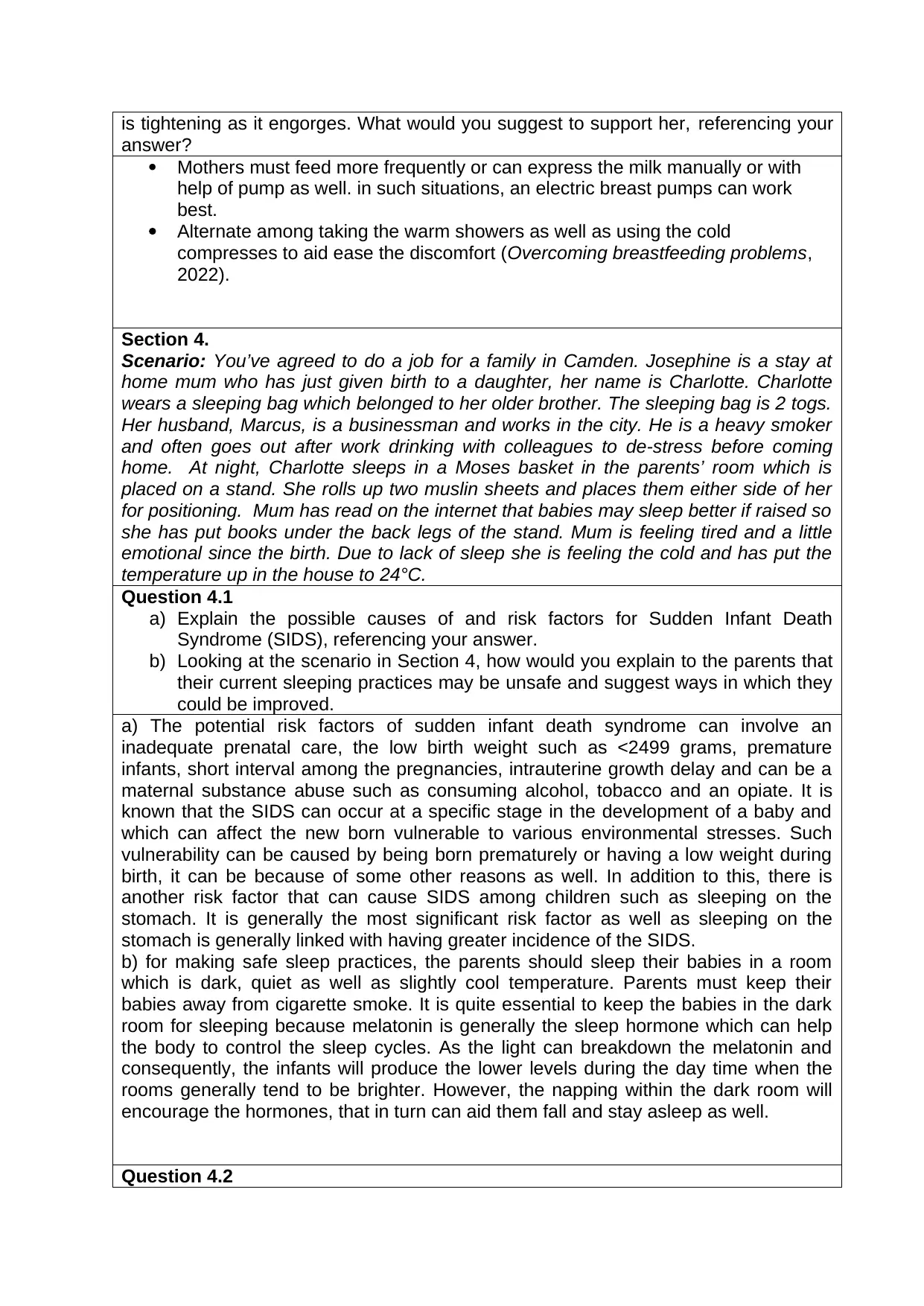
is tightening as it engorges. What would you suggest to support her, referencing your
answer?
Mothers must feed more frequently or can express the milk manually or with
help of pump as well. in such situations, an electric breast pumps can work
best.
Alternate among taking the warm showers as well as using the cold
compresses to aid ease the discomfort (Overcoming breastfeeding problems,
2022).
Section 4.
Scenario: You’ve agreed to do a job for a family in Camden. Josephine is a stay at
home mum who has just given birth to a daughter, her name is Charlotte. Charlotte
wears a sleeping bag which belonged to her older brother. The sleeping bag is 2 togs.
Her husband, Marcus, is a businessman and works in the city. He is a heavy smoker
and often goes out after work drinking with colleagues to de-stress before coming
home. At night, Charlotte sleeps in a Moses basket in the parents’ room which is
placed on a stand. She rolls up two muslin sheets and places them either side of her
for positioning. Mum has read on the internet that babies may sleep better if raised so
she has put books under the back legs of the stand. Mum is feeling tired and a little
emotional since the birth. Due to lack of sleep she is feeling the cold and has put the
temperature up in the house to 24°C.
Question 4.1
a) Explain the possible causes of and risk factors for Sudden Infant Death
Syndrome (SIDS), referencing your answer.
b) Looking at the scenario in Section 4, how would you explain to the parents that
their current sleeping practices may be unsafe and suggest ways in which they
could be improved.
a) The potential risk factors of sudden infant death syndrome can involve an
inadequate prenatal care, the low birth weight such as <2499 grams, premature
infants, short interval among the pregnancies, intrauterine growth delay and can be a
maternal substance abuse such as consuming alcohol, tobacco and an opiate. It is
known that the SIDS can occur at a specific stage in the development of a baby and
which can affect the new born vulnerable to various environmental stresses. Such
vulnerability can be caused by being born prematurely or having a low weight during
birth, it can be because of some other reasons as well. In addition to this, there is
another risk factor that can cause SIDS among children such as sleeping on the
stomach. It is generally the most significant risk factor as well as sleeping on the
stomach is generally linked with having greater incidence of the SIDS.
b) for making safe sleep practices, the parents should sleep their babies in a room
which is dark, quiet as well as slightly cool temperature. Parents must keep their
babies away from cigarette smoke. It is quite essential to keep the babies in the dark
room for sleeping because melatonin is generally the sleep hormone which can help
the body to control the sleep cycles. As the light can breakdown the melatonin and
consequently, the infants will produce the lower levels during the day time when the
rooms generally tend to be brighter. However, the napping within the dark room will
encourage the hormones, that in turn can aid them fall and stay asleep as well.
Question 4.2
answer?
Mothers must feed more frequently or can express the milk manually or with
help of pump as well. in such situations, an electric breast pumps can work
best.
Alternate among taking the warm showers as well as using the cold
compresses to aid ease the discomfort (Overcoming breastfeeding problems,
2022).
Section 4.
Scenario: You’ve agreed to do a job for a family in Camden. Josephine is a stay at
home mum who has just given birth to a daughter, her name is Charlotte. Charlotte
wears a sleeping bag which belonged to her older brother. The sleeping bag is 2 togs.
Her husband, Marcus, is a businessman and works in the city. He is a heavy smoker
and often goes out after work drinking with colleagues to de-stress before coming
home. At night, Charlotte sleeps in a Moses basket in the parents’ room which is
placed on a stand. She rolls up two muslin sheets and places them either side of her
for positioning. Mum has read on the internet that babies may sleep better if raised so
she has put books under the back legs of the stand. Mum is feeling tired and a little
emotional since the birth. Due to lack of sleep she is feeling the cold and has put the
temperature up in the house to 24°C.
Question 4.1
a) Explain the possible causes of and risk factors for Sudden Infant Death
Syndrome (SIDS), referencing your answer.
b) Looking at the scenario in Section 4, how would you explain to the parents that
their current sleeping practices may be unsafe and suggest ways in which they
could be improved.
a) The potential risk factors of sudden infant death syndrome can involve an
inadequate prenatal care, the low birth weight such as <2499 grams, premature
infants, short interval among the pregnancies, intrauterine growth delay and can be a
maternal substance abuse such as consuming alcohol, tobacco and an opiate. It is
known that the SIDS can occur at a specific stage in the development of a baby and
which can affect the new born vulnerable to various environmental stresses. Such
vulnerability can be caused by being born prematurely or having a low weight during
birth, it can be because of some other reasons as well. In addition to this, there is
another risk factor that can cause SIDS among children such as sleeping on the
stomach. It is generally the most significant risk factor as well as sleeping on the
stomach is generally linked with having greater incidence of the SIDS.
b) for making safe sleep practices, the parents should sleep their babies in a room
which is dark, quiet as well as slightly cool temperature. Parents must keep their
babies away from cigarette smoke. It is quite essential to keep the babies in the dark
room for sleeping because melatonin is generally the sleep hormone which can help
the body to control the sleep cycles. As the light can breakdown the melatonin and
consequently, the infants will produce the lower levels during the day time when the
rooms generally tend to be brighter. However, the napping within the dark room will
encourage the hormones, that in turn can aid them fall and stay asleep as well.
Question 4.2
⊘ This is a preview!⊘
Do you want full access?
Subscribe today to unlock all pages.

Trusted by 1+ million students worldwide
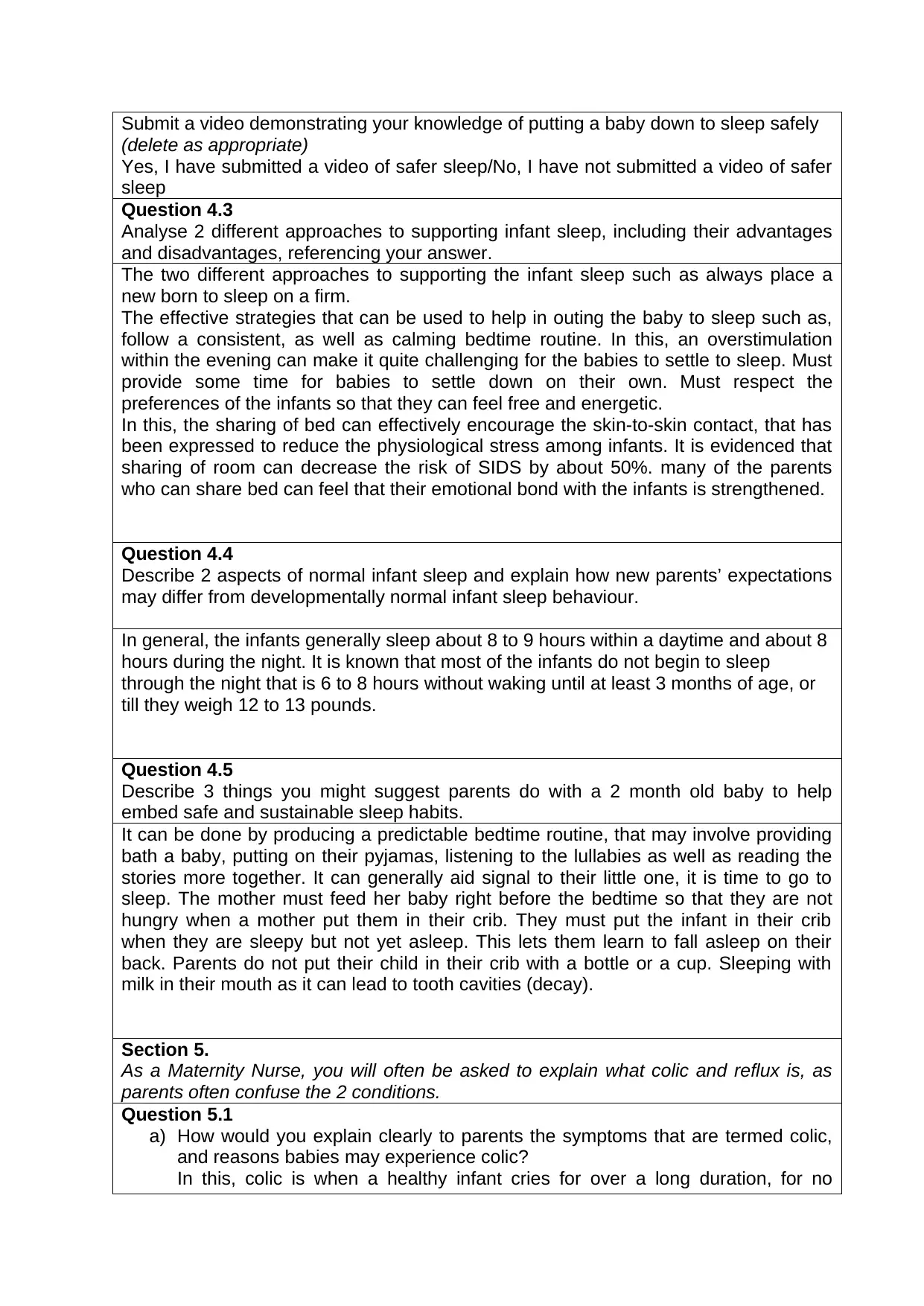
Submit a video demonstrating your knowledge of putting a baby down to sleep safely
(delete as appropriate)
Yes, I have submitted a video of safer sleep/No, I have not submitted a video of safer
sleep
Question 4.3
Analyse 2 different approaches to supporting infant sleep, including their advantages
and disadvantages, referencing your answer.
The two different approaches to supporting the infant sleep such as always place a
new born to sleep on a firm.
The effective strategies that can be used to help in outing the baby to sleep such as,
follow a consistent, as well as calming bedtime routine. In this, an overstimulation
within the evening can make it quite challenging for the babies to settle to sleep. Must
provide some time for babies to settle down on their own. Must respect the
preferences of the infants so that they can feel free and energetic.
In this, the sharing of bed can effectively encourage the skin-to-skin contact, that has
been expressed to reduce the physiological stress among infants. It is evidenced that
sharing of room can decrease the risk of SIDS by about 50%. many of the parents
who can share bed can feel that their emotional bond with the infants is strengthened.
Question 4.4
Describe 2 aspects of normal infant sleep and explain how new parents’ expectations
may differ from developmentally normal infant sleep behaviour.
In general, the infants generally sleep about 8 to 9 hours within a daytime and about 8
hours during the night. It is known that most of the infants do not begin to sleep
through the night that is 6 to 8 hours without waking until at least 3 months of age, or
till they weigh 12 to 13 pounds.
Question 4.5
Describe 3 things you might suggest parents do with a 2 month old baby to help
embed safe and sustainable sleep habits.
It can be done by producing a predictable bedtime routine, that may involve providing
bath a baby, putting on their pyjamas, listening to the lullabies as well as reading the
stories more together. It can generally aid signal to their little one, it is time to go to
sleep. The mother must feed her baby right before the bedtime so that they are not
hungry when a mother put them in their crib. They must put the infant in their crib
when they are sleepy but not yet asleep. This lets them learn to fall asleep on their
back. Parents do not put their child in their crib with a bottle or a cup. Sleeping with
milk in their mouth as it can lead to tooth cavities (decay).
Section 5.
As a Maternity Nurse, you will often be asked to explain what colic and reflux is, as
parents often confuse the 2 conditions.
Question 5.1
a) How would you explain clearly to parents the symptoms that are termed colic,
and reasons babies may experience colic?
In this, colic is when a healthy infant cries for over a long duration, for no
(delete as appropriate)
Yes, I have submitted a video of safer sleep/No, I have not submitted a video of safer
sleep
Question 4.3
Analyse 2 different approaches to supporting infant sleep, including their advantages
and disadvantages, referencing your answer.
The two different approaches to supporting the infant sleep such as always place a
new born to sleep on a firm.
The effective strategies that can be used to help in outing the baby to sleep such as,
follow a consistent, as well as calming bedtime routine. In this, an overstimulation
within the evening can make it quite challenging for the babies to settle to sleep. Must
provide some time for babies to settle down on their own. Must respect the
preferences of the infants so that they can feel free and energetic.
In this, the sharing of bed can effectively encourage the skin-to-skin contact, that has
been expressed to reduce the physiological stress among infants. It is evidenced that
sharing of room can decrease the risk of SIDS by about 50%. many of the parents
who can share bed can feel that their emotional bond with the infants is strengthened.
Question 4.4
Describe 2 aspects of normal infant sleep and explain how new parents’ expectations
may differ from developmentally normal infant sleep behaviour.
In general, the infants generally sleep about 8 to 9 hours within a daytime and about 8
hours during the night. It is known that most of the infants do not begin to sleep
through the night that is 6 to 8 hours without waking until at least 3 months of age, or
till they weigh 12 to 13 pounds.
Question 4.5
Describe 3 things you might suggest parents do with a 2 month old baby to help
embed safe and sustainable sleep habits.
It can be done by producing a predictable bedtime routine, that may involve providing
bath a baby, putting on their pyjamas, listening to the lullabies as well as reading the
stories more together. It can generally aid signal to their little one, it is time to go to
sleep. The mother must feed her baby right before the bedtime so that they are not
hungry when a mother put them in their crib. They must put the infant in their crib
when they are sleepy but not yet asleep. This lets them learn to fall asleep on their
back. Parents do not put their child in their crib with a bottle or a cup. Sleeping with
milk in their mouth as it can lead to tooth cavities (decay).
Section 5.
As a Maternity Nurse, you will often be asked to explain what colic and reflux is, as
parents often confuse the 2 conditions.
Question 5.1
a) How would you explain clearly to parents the symptoms that are termed colic,
and reasons babies may experience colic?
In this, colic is when a healthy infant cries for over a long duration, for no
Paraphrase This Document
Need a fresh take? Get an instant paraphrase of this document with our AI Paraphraser
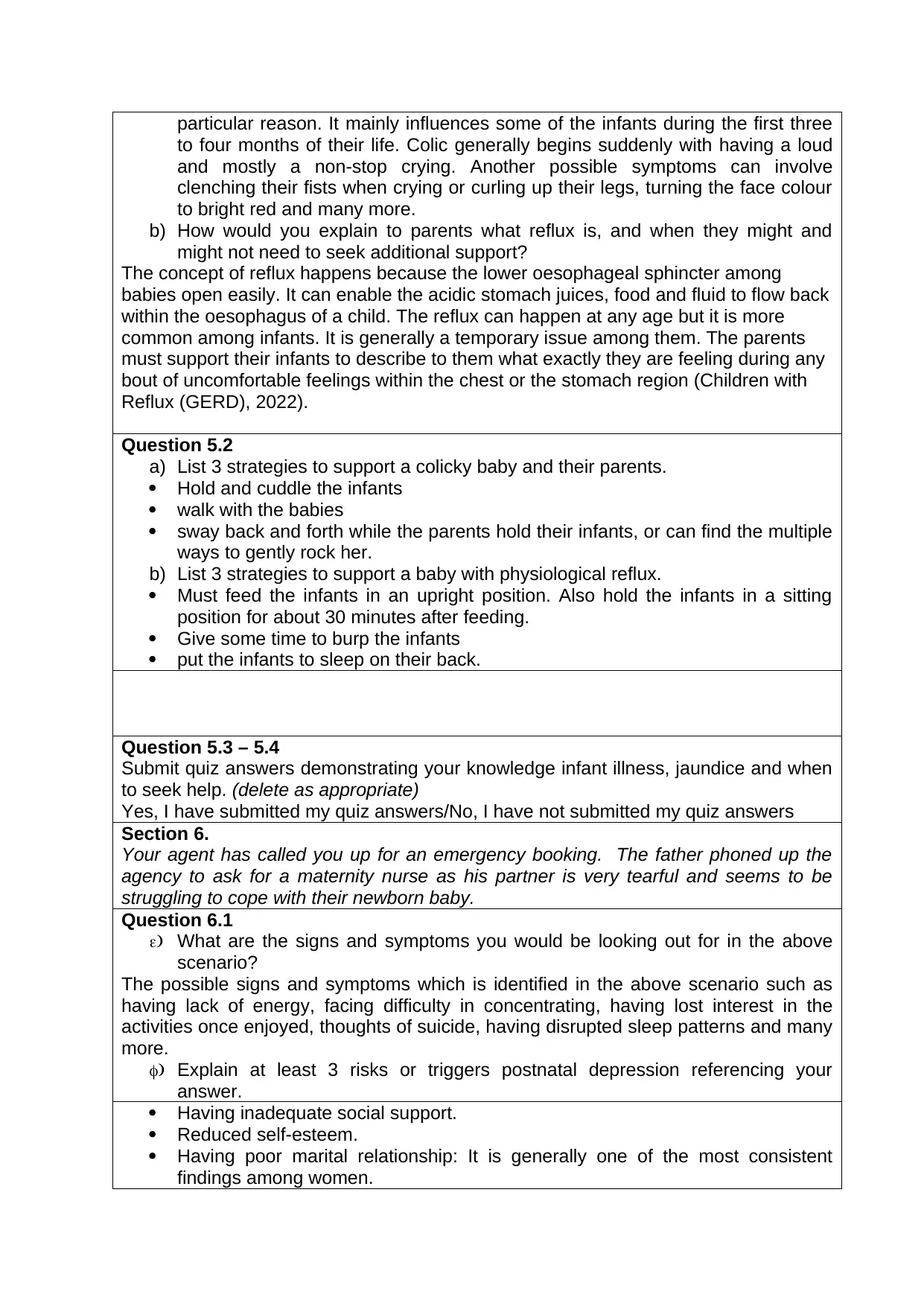
particular reason. It mainly influences some of the infants during the first three
to four months of their life. Colic generally begins suddenly with having a loud
and mostly a non-stop crying. Another possible symptoms can involve
clenching their fists when crying or curling up their legs, turning the face colour
to bright red and many more.
b) How would you explain to parents what reflux is, and when they might and
might not need to seek additional support?
The concept of reflux happens because the lower oesophageal sphincter among
babies open easily. It can enable the acidic stomach juices, food and fluid to flow back
within the oesophagus of a child. The reflux can happen at any age but it is more
common among infants. It is generally a temporary issue among them. The parents
must support their infants to describe to them what exactly they are feeling during any
bout of uncomfortable feelings within the chest or the stomach region (Children with
Reflux (GERD), 2022).
Question 5.2
a) List 3 strategies to support a colicky baby and their parents.
Hold and cuddle the infants
walk with the babies
sway back and forth while the parents hold their infants, or can find the multiple
ways to gently rock her.
b) List 3 strategies to support a baby with physiological reflux.
Must feed the infants in an upright position. Also hold the infants in a sitting
position for about 30 minutes after feeding.
Give some time to burp the infants
put the infants to sleep on their back.
Question 5.3 – 5.4
Submit quiz answers demonstrating your knowledge infant illness, jaundice and when
to seek help. (delete as appropriate)
Yes, I have submitted my quiz answers/No, I have not submitted my quiz answers
Section 6.
Your agent has called you up for an emergency booking. The father phoned up the
agency to ask for a maternity nurse as his partner is very tearful and seems to be
struggling to cope with their newborn baby.
Question 6.1
e) What are the signs and symptoms you would be looking out for in the above
scenario?
The possible signs and symptoms which is identified in the above scenario such as
having lack of energy, facing difficulty in concentrating, having lost interest in the
activities once enjoyed, thoughts of suicide, having disrupted sleep patterns and many
more.
f) Explain at least 3 risks or triggers postnatal depression referencing your
answer.
Having inadequate social support.
Reduced self-esteem.
Having poor marital relationship: It is generally one of the most consistent
findings among women.
to four months of their life. Colic generally begins suddenly with having a loud
and mostly a non-stop crying. Another possible symptoms can involve
clenching their fists when crying or curling up their legs, turning the face colour
to bright red and many more.
b) How would you explain to parents what reflux is, and when they might and
might not need to seek additional support?
The concept of reflux happens because the lower oesophageal sphincter among
babies open easily. It can enable the acidic stomach juices, food and fluid to flow back
within the oesophagus of a child. The reflux can happen at any age but it is more
common among infants. It is generally a temporary issue among them. The parents
must support their infants to describe to them what exactly they are feeling during any
bout of uncomfortable feelings within the chest or the stomach region (Children with
Reflux (GERD), 2022).
Question 5.2
a) List 3 strategies to support a colicky baby and their parents.
Hold and cuddle the infants
walk with the babies
sway back and forth while the parents hold their infants, or can find the multiple
ways to gently rock her.
b) List 3 strategies to support a baby with physiological reflux.
Must feed the infants in an upright position. Also hold the infants in a sitting
position for about 30 minutes after feeding.
Give some time to burp the infants
put the infants to sleep on their back.
Question 5.3 – 5.4
Submit quiz answers demonstrating your knowledge infant illness, jaundice and when
to seek help. (delete as appropriate)
Yes, I have submitted my quiz answers/No, I have not submitted my quiz answers
Section 6.
Your agent has called you up for an emergency booking. The father phoned up the
agency to ask for a maternity nurse as his partner is very tearful and seems to be
struggling to cope with their newborn baby.
Question 6.1
e) What are the signs and symptoms you would be looking out for in the above
scenario?
The possible signs and symptoms which is identified in the above scenario such as
having lack of energy, facing difficulty in concentrating, having lost interest in the
activities once enjoyed, thoughts of suicide, having disrupted sleep patterns and many
more.
f) Explain at least 3 risks or triggers postnatal depression referencing your
answer.
Having inadequate social support.
Reduced self-esteem.
Having poor marital relationship: It is generally one of the most consistent
findings among women.
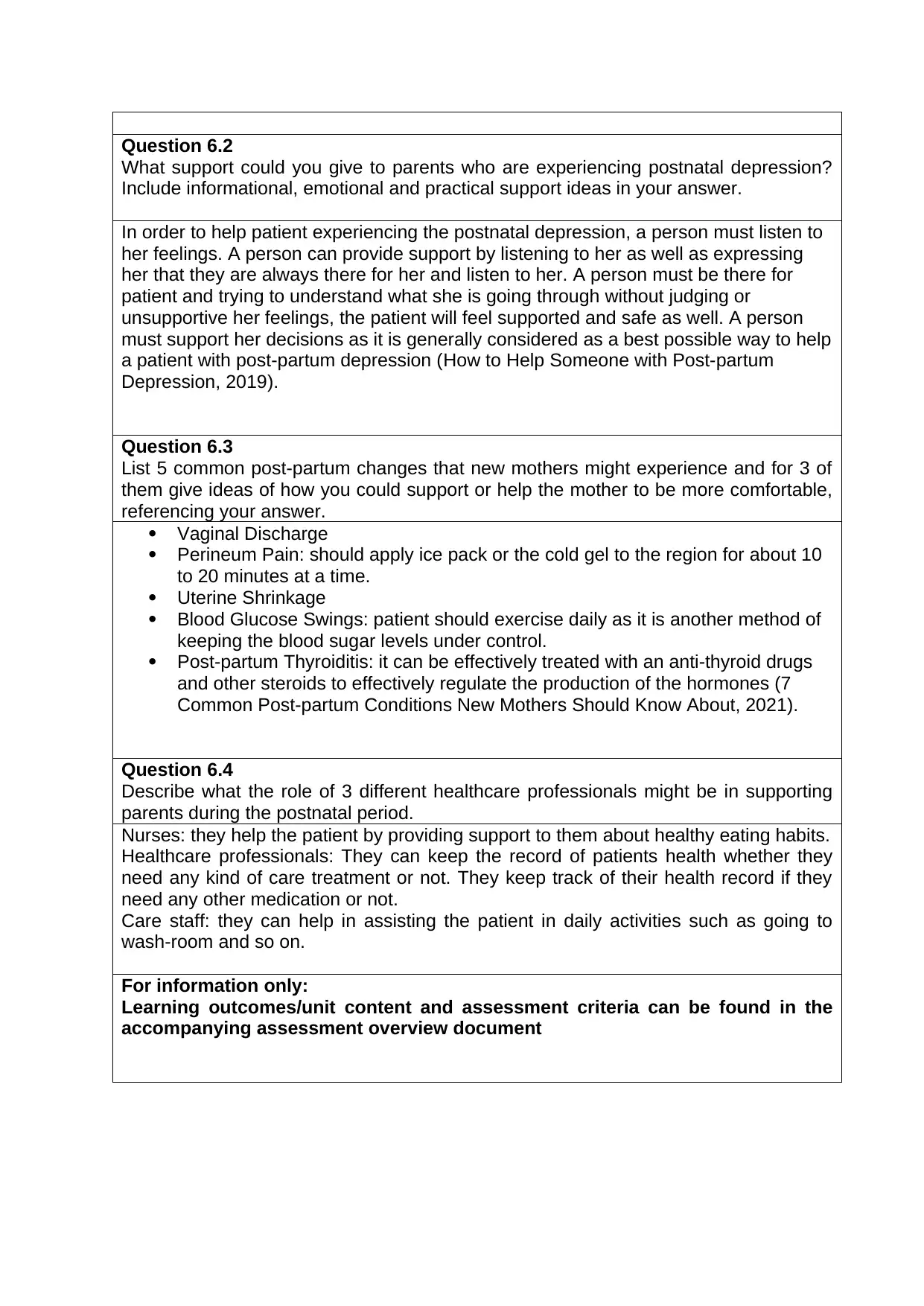
Question 6.2
What support could you give to parents who are experiencing postnatal depression?
Include informational, emotional and practical support ideas in your answer.
In order to help patient experiencing the postnatal depression, a person must listen to
her feelings. A person can provide support by listening to her as well as expressing
her that they are always there for her and listen to her. A person must be there for
patient and trying to understand what she is going through without judging or
unsupportive her feelings, the patient will feel supported and safe as well. A person
must support her decisions as it is generally considered as a best possible way to help
a patient with post-partum depression (How to Help Someone with Post-partum
Depression, 2019).
Question 6.3
List 5 common post-partum changes that new mothers might experience and for 3 of
them give ideas of how you could support or help the mother to be more comfortable,
referencing your answer.
Vaginal Discharge
Perineum Pain: should apply ice pack or the cold gel to the region for about 10
to 20 minutes at a time.
Uterine Shrinkage
Blood Glucose Swings: patient should exercise daily as it is another method of
keeping the blood sugar levels under control.
Post-partum Thyroiditis: it can be effectively treated with an anti-thyroid drugs
and other steroids to effectively regulate the production of the hormones (7
Common Post-partum Conditions New Mothers Should Know About, 2021).
Question 6.4
Describe what the role of 3 different healthcare professionals might be in supporting
parents during the postnatal period.
Nurses: they help the patient by providing support to them about healthy eating habits.
Healthcare professionals: They can keep the record of patients health whether they
need any kind of care treatment or not. They keep track of their health record if they
need any other medication or not.
Care staff: they can help in assisting the patient in daily activities such as going to
wash-room and so on.
For information only:
Learning outcomes/unit content and assessment criteria can be found in the
accompanying assessment overview document
What support could you give to parents who are experiencing postnatal depression?
Include informational, emotional and practical support ideas in your answer.
In order to help patient experiencing the postnatal depression, a person must listen to
her feelings. A person can provide support by listening to her as well as expressing
her that they are always there for her and listen to her. A person must be there for
patient and trying to understand what she is going through without judging or
unsupportive her feelings, the patient will feel supported and safe as well. A person
must support her decisions as it is generally considered as a best possible way to help
a patient with post-partum depression (How to Help Someone with Post-partum
Depression, 2019).
Question 6.3
List 5 common post-partum changes that new mothers might experience and for 3 of
them give ideas of how you could support or help the mother to be more comfortable,
referencing your answer.
Vaginal Discharge
Perineum Pain: should apply ice pack or the cold gel to the region for about 10
to 20 minutes at a time.
Uterine Shrinkage
Blood Glucose Swings: patient should exercise daily as it is another method of
keeping the blood sugar levels under control.
Post-partum Thyroiditis: it can be effectively treated with an anti-thyroid drugs
and other steroids to effectively regulate the production of the hormones (7
Common Post-partum Conditions New Mothers Should Know About, 2021).
Question 6.4
Describe what the role of 3 different healthcare professionals might be in supporting
parents during the postnatal period.
Nurses: they help the patient by providing support to them about healthy eating habits.
Healthcare professionals: They can keep the record of patients health whether they
need any kind of care treatment or not. They keep track of their health record if they
need any other medication or not.
Care staff: they can help in assisting the patient in daily activities such as going to
wash-room and so on.
For information only:
Learning outcomes/unit content and assessment criteria can be found in the
accompanying assessment overview document
⊘ This is a preview!⊘
Do you want full access?
Subscribe today to unlock all pages.

Trusted by 1+ million students worldwide
1 out of 9
Related Documents
Your All-in-One AI-Powered Toolkit for Academic Success.
+13062052269
info@desklib.com
Available 24*7 on WhatsApp / Email
![[object Object]](/_next/static/media/star-bottom.7253800d.svg)
Unlock your academic potential
Copyright © 2020–2025 A2Z Services. All Rights Reserved. Developed and managed by ZUCOL.





